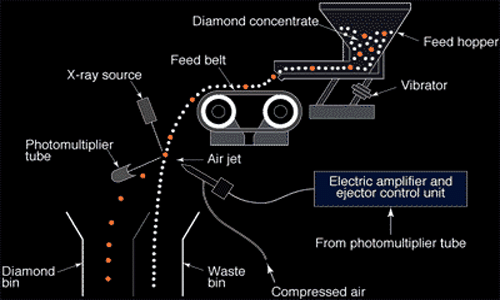Processing Diamond Ore
Once a mining process yields ore, the diamonds must be sorted from the other materials. This process relies mainly on diamond's high density. An old but useful method is to use a washing pan, which forces heavy minerals like diamond to the bottom and waste to the top. Cones and cyclones use swirling serious fluids mixed with crushed ore to achieve density separations. With 99 percent of the waste in the ore removed, more separations may use either a grease table or an x-ray separator. Final separation and sorting is done by eye.
Crushed ore is mixed with a muddy water suspension, called puddle, and all is stimulated by angled rotating blades in the circular washing pan. Heavier minerals settle to the bottom and are pushed toward an exit point, whereas lighter waste rise to the top and overflows as a separate stream of material.
The working grease table at Longlands, Cape Province, South Africa. The surface of diamond is extremely unusual in that it resists being wetted by water but sticks readily to grease. Here, wet gravel washes across 3 disposed surfaces covered with beeswax and paraffin. Diamonds stick to the grease though wetted waste minerals flow past. The operator regularly scrapes the material that adheres to the table into a grease pot, using a trowel. The grease in the container is melted and the diamonds are removed in a strainer. More mechanical systems use a rotating grease belt and scraper.

Diamond-bearing concentrate is mixed with a fluid by the density of diamond. Separation forms in cones and cyclones by swirling the mixture at low and high velocities respectively. In the cone, rotational mixing permits lighter minerals to float to the top and run out as overflow, whereas diamonds and dense minerals sink to the bottom and are sucked out with a compressed air siphon. In the cyclone, fast rotation of the suspension drives heavy minerals to the conical wall, where they sink to the bottom and are extracted, though float waste minerals are sucked from the center of the vortex. Cyclones are about 99.999% efficient at concentrating diamonds and also dense minerals from the original ore.
The x-ray partition system acts on a thin stream of particles from the concentrate accelerated off a moving belt into the air, where they encounter an intense beam of x-rays. Several diamonds fluoresces in the x-rays, activating a photomultiplier that triggers a jet of air, deflecting the diamonds (red) into a collector bin.
<< Back | Next >>